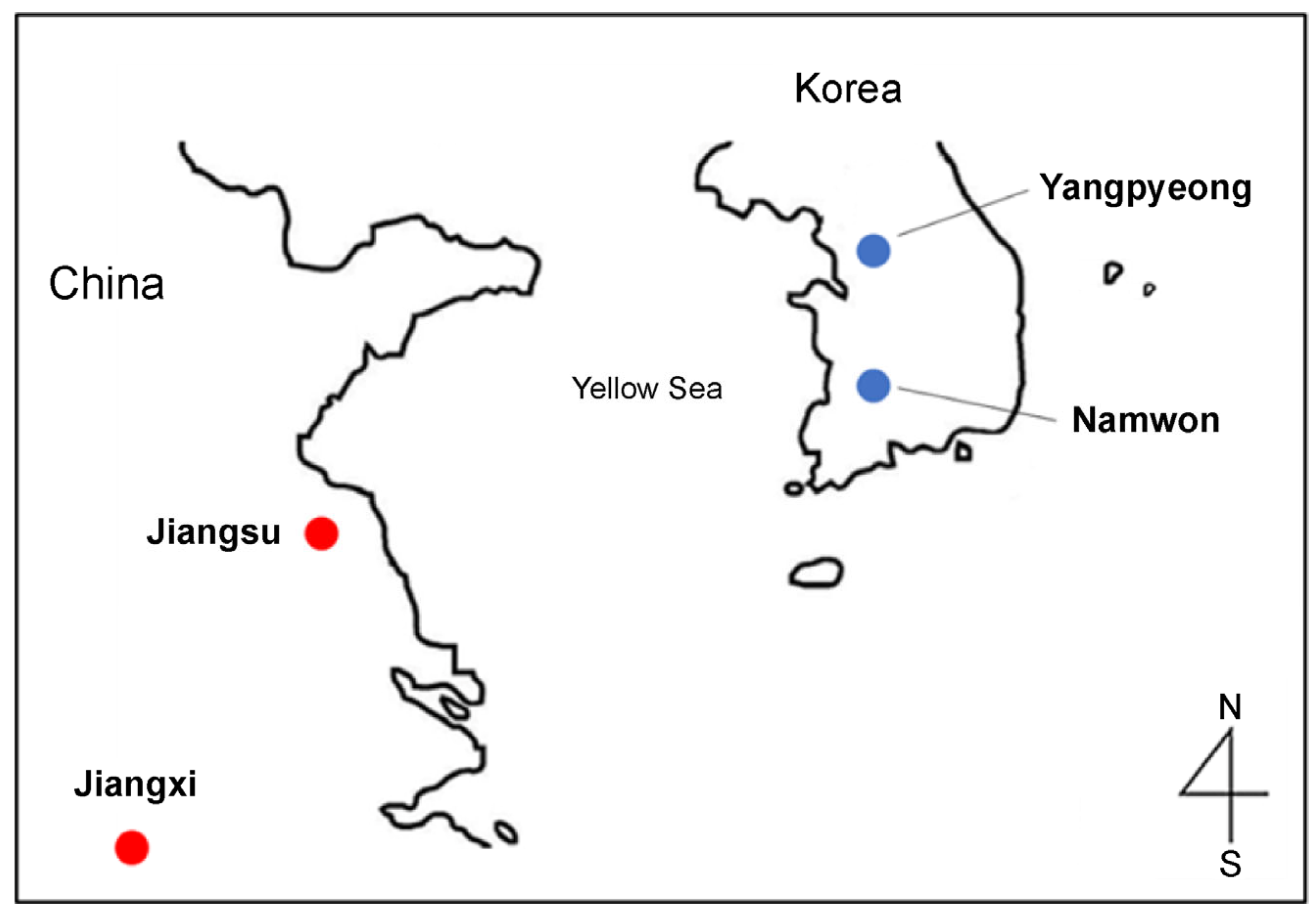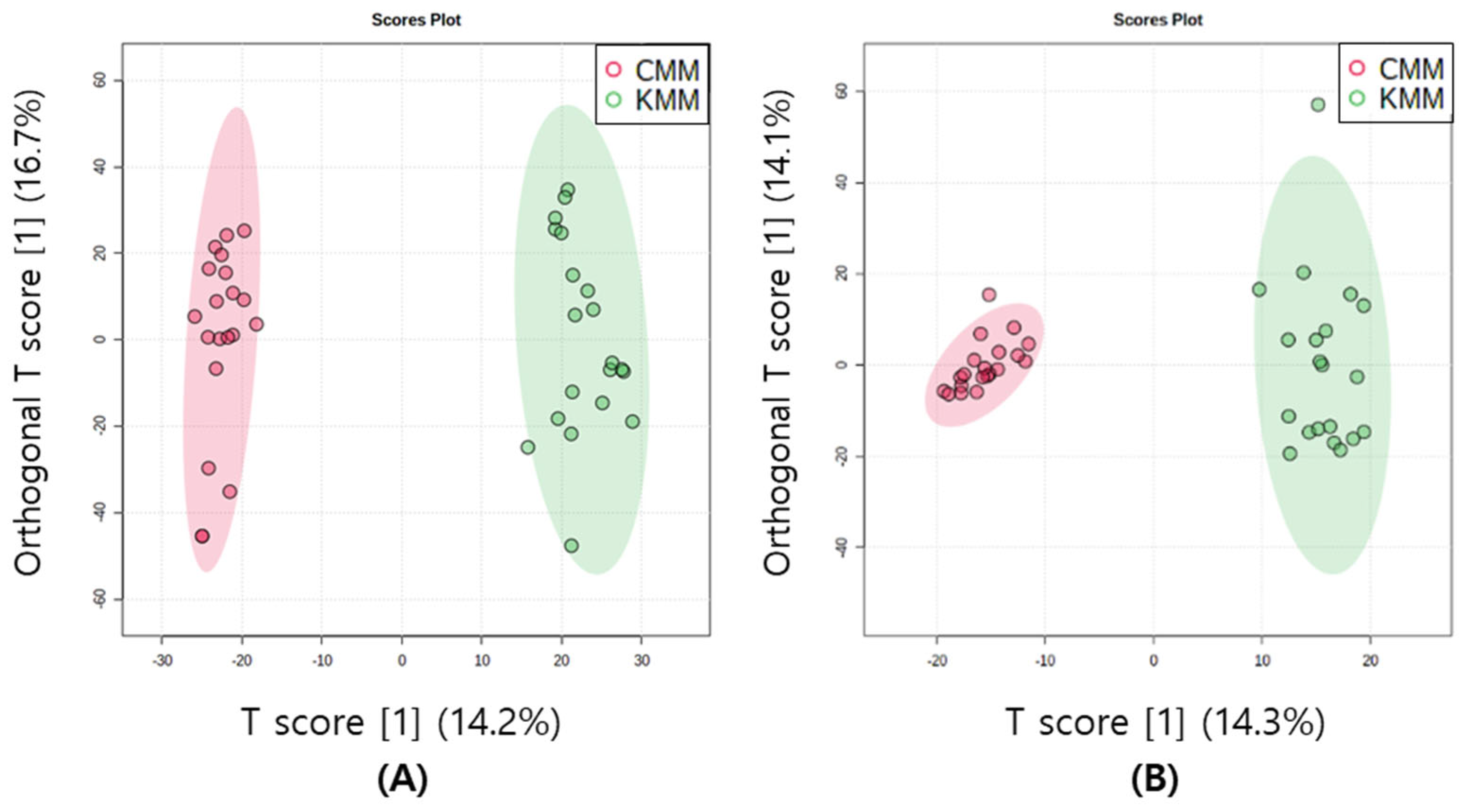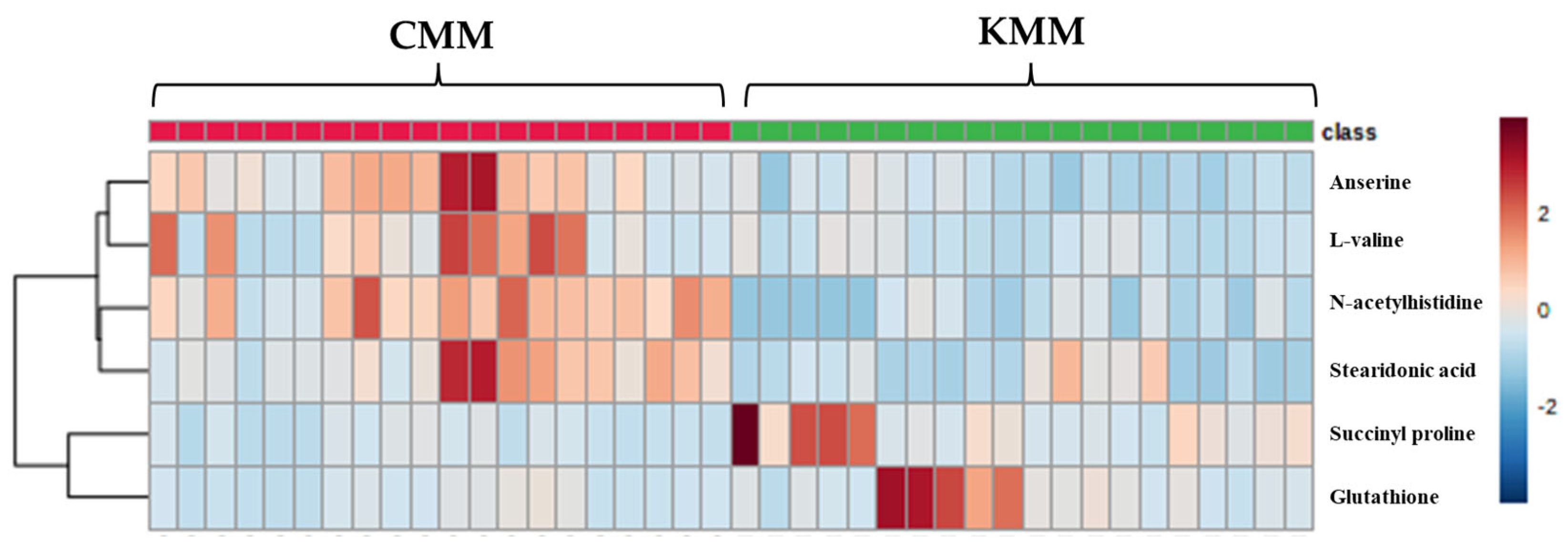Biomarker Development for Identifying Mud Loach (Misgurnus mizolepis) Origin Country Using Untargeted Metabolite Profiling
Abstract
1. Introduction
2. Materials and Methods
2.1. Sample Collection and Preparation
2.2. Metabolite Extraction
2.3. LC-Quadrupole-Time-of-Flight (QTOF)/MS Analyses
2.4. Data Processing
2.5. Chemicals and Reagents
3. Results
3.1. Metabolite Profiling of the Mud Loach
3.2. PCA and OPLS-DA for Geographic Differentiation of the Mud Loach
3.3. Identification of Differential Metabolites as Biomarkers
4. Discussion
5. Conclusions
Author Contributions
Funding
Institutional Review Board Statement
Informed Consent Statement
Data Availability Statement
Conflicts of Interest
References
- Kim, E.M.; Dong, C.M.; Lee, M.N.; Noh, J.K.; Noh, E.S.; Nam, B.H.; Kim, Y.O.; Jung, H.S. Development of multiplex species-specific PCR for the simultaneous identification of three closely related species in the genera Misgurnus and Paramisgurnus. Aquacult. Rep. 2022, 24, 101144. [Google Scholar] [CrossRef]
- Song, H.Y.; Moon, S.J.; Kim, K.S.; Bang, I.C. Genetic species identification by sequencing analysis of nuclear and mitochondrial genes for albino Misgurnus species from Korea. Korean J. Ichthyol. 2017, 29, 139–145. [Google Scholar]
- Choi, B.K.; Choe, J.R.; Lee, J.H.; Park, J.S.; Kim, J.E.; Hwang, J.A.; Kim, H.S. Fish farm monitoring and growth performances of Chinese muddy loach (Misgurnus mizolepis) under indoor or outdoor aquaculture conditions, Korea. Korean J. Ichthyol. 2020, 32, 232–238. [Google Scholar] [CrossRef]
- Dettmer, K.; Aronov, P.A.; Hammock, B.D. Mass spectrometry-based metabolomics. Mass Spectrom. Rev. 2007, 26, 51–78. [Google Scholar] [CrossRef] [PubMed]
- Hoffmann, J.F.; Carvalho, I.R.; Barbieri, R.L.; Rombaldi, C.V.; Chaves, F.C. Butia spp. (Arecaceae) LC-MS-based metabolomics for species and geographical origin discrimination. J. Agric. Food Chem. 2017, 65, 523–532. [Google Scholar] [CrossRef] [PubMed]
- Kim, E.J.; Kwon, J.; Park, S.H.; Park, C.Y.; Seo, Y.B.; Shin, H.K.; Kim, H.K.; Lee, K.S.; Choi, S.Y.; Ryu, D.H.; et al. Metabolite profiling of Angelica gigas from different geographical origins using 1H NMR and UPLC-MS analyses. J. Agric. Food Chem. 2011, 59, 8806–8815. [Google Scholar] [CrossRef]
- Mihailova, A.; Kelly, S.D.; Chevallier, O.P.; Elliott, C.T.; Maestroni, B.M.; Cannavan, A. High-resolution mass spectrometry-based metabolomics for the discrimination between organic and conventional crops: A review. Trends Food Sci. Technol. 2021, 110, 142–154. [Google Scholar] [CrossRef]
- Wang, Y.; Li, C.; Li, L.; Yang, X.; Chen, S.; Wu, Y.; Zhao, Y.; Wang, J.; Wei, Y.; Yang, D. Application of UHPLC-Q/TOF-MS-based metabolomics in the evaluation of metabolites and taste quality of Chinese fish sauce (Yu-lu) during fermentation. Food Chem. 2019, 296, 132–141. [Google Scholar] [CrossRef]
- Lee, J.E.; Lee, B.J.; Chung, J.O.; Kim, H.N.; Kim, E.H.; Jung, S.H.; Lee, H.S.; Lee, S.J.; Hong, Y.S. Metabolomic unveiling of a diverse range of green tea (Camellia sinensis) metabolites dependent on geography. Food Chem. 2015, 174, 452–459. [Google Scholar] [CrossRef]
- Shin, J.Y.; Yang, J.H.; Cha, E.J.; Kim, H.S.; Lee, Y.H.; Kim, S.; Choi, I.; Yang, J.Y. Analyzing the metabolomic profile of yellowtail (Seriola quinquerdiata) by capillary electrophoresis–time of flight mass spectrometry to determine geographical origin. Metabolites 2021, 11, 793. [Google Scholar] [CrossRef]
- Yang, J.H.; Shin, J.Y.; Cha, E.J.; Kim, H.S.; Lee, Y.H.; Kim, S.; Choi, I.; Yang, J.Y. Analysis of metabolites of red seabream (Pagrus major) from different geographical origins by capillary electrophoresis time-of-flight mass spectrometry. PLoS ONE 2022, 17, e0270280. [Google Scholar] [CrossRef] [PubMed]
- Zhao, G.; Zhao, W.; Han, L.; Ding, J.; Chang, Y. Metabolomics analysis of sea cucumber (Apostichopus japonicus) in different geographical origins using UPLC–Q-TOF/MS. Food Chem. 2020, 333, 127453. [Google Scholar] [CrossRef] [PubMed]
- Granato, D.; Santos, J.S.; Escher, G.B.; Ferreira, B.L.; Maggio, R.M. Use of principal component analysis (PCA) and hierarchical cluster analysis (HCA) for multivariate association between bioactive compounds and functional properties in foods: A critical perspective. Trends Food Sci. Technol. 2018, 72, 83–90. [Google Scholar] [CrossRef]
- Abdi, H.; Williams, L.J. Principal component analysis. Wiley Interdiscip. Rev. Comput. Stat. 2010, 2, 433–459. [Google Scholar] [CrossRef]
- Kang, C.; Zhang, Y.; Zhang, M.; Qi, J.; Zhao, W.; Gu, J.; Guo, W.; Li, Y. Screening of specific quantitative peptides of beef by LC–MS/MS coupled with OPLS-DA. Food Chem. 2022, 387, 132932. [Google Scholar] [CrossRef]
- Zhao, S.; Liu, H.; Su, Z.; Khoo, C.; Gu, L. Identifying cranberry juice consumers with predictive OPLS-DA models of plasma metabolome and validation of cranberry juice intake biomarkers in a double-blinded, randomized, placebo-controlled, cross-over study. Mol. Nutr. Food Res. 2020, 64, e1901242. [Google Scholar] [CrossRef] [PubMed]
- Zhao, G.; Zhai, X.; Qu, M.; Tong, C.; Li, W. Sulfated modification of the polysaccharides from Crassostrea gigas and their antioxidant and hepatoprotective activities through metabolomics analysis. Int. J. Biol. Macromol. 2019, 129, 386–395. [Google Scholar] [CrossRef]
- Xia, J.; Broadhurst, D.I.; Wilson, M.; Wishart, D.S. Translational biomarker discovery in clinical metabolomics: An introductory tutorial. Metabolomics 2013, 9, 280–299. [Google Scholar] [CrossRef]
- Rivera-Pérez, A.; Romero-González, R.; Frenich, A.G. Application of an innovative metabolomics approach to discriminate geographical origin and processing of black pepper by untargeted UHPLC-Q-Orbitrap-HRMS analysis and mid-level data fusion. Food Res. Int. 2021, 150, 110722. [Google Scholar] [CrossRef]
- Bondia-Pons, I.; Savolainen, O.; Törrönen, R.; Martinez, J.A.; Poutanen, K.; Hanhineva, K. Metabolic profiling of Goji berry extracts for discrimination of geographical origin by non-targeted liquid chromatography coupled to quadrupole time-of-flight mass spectrometry. Food Res. Int. 2014, 63, 132–138. [Google Scholar] [CrossRef]
- Kim, T.J.; Park, J.G.; Kim, H.Y.; Ha, S.H.; Lee, B.; Park, S.U.; Seo, W.D.; Kim, J.K. Metabolite profiling and chemometric study for the discrimination analyses of geographic origin of perilla (Perilla frutescens) and sesame (Sesamum indicum) seeds. Foods 2020, 9, 989. [Google Scholar] [CrossRef]
- Sun, B.; Zheng, A.H.; Zhang, F.; Wei, K.S.; Chen, Q.; Luo, Y.; Zhang, Y.; Wang, X.R.; Lin, F.C.; Yang, J.; et al. Metabolic profiles of Cuibi-1 and Zhongyan-100 flue-cured tobacco leaves in different growing regions by gas chromatography/mass spectrometry. R. Soc. Open Sci. 2018, 5, 180261. [Google Scholar] [CrossRef]
- Jung, Y.; Lee, J.; Kwon, J.; Lee, K.S.; Ryu, D.H.; Hwang, G.S. Discrimination of the geographical origin of beef by 1H NMR-based metabolomics. J. Agric. Food Chem. 2010, 58, 10458–10466. [Google Scholar] [CrossRef]
- Soonchunhyang University Industry Academy Cooperation Foundation. Primers for Distinguishing Misgurnus mizolepis and Method Using the Same. Korea Patent 10-2012-0077094, 16 July 2012. [Google Scholar]
- Want, E.J.; Wilson, I.D.; Gika, H.; Theodoridis, G.; Plumb, R.S.; Shockcor, J.; Holmes, E.; Nicholson, J.K. Global metabolic profiling procedures for urine using UPLC–MS. Nat. Protoc. 2010, 5, 1005–1018. [Google Scholar] [CrossRef]
- Triba, M.N.; Le Moyec, L.; Amathieu, R.; Goossens, C.; Bouchemal, N.; Nahon, P.; Rutledge, D.; Savarin, P. PLS/OPLS models in metabolomics: The impact of permutation of dataset rows on the K-fold cross-validation quality parameters. Mol. Biosyst. 2015, 11, 13–19. [Google Scholar] [CrossRef]
- Umetrics. User Guide SIMCA-+ 12; Umetrics: Umea, Sweden, 2008. [Google Scholar]
- Chong, I.G.; Jun, C.H. Performance of some variable selection methods when multicollinearity is present. Chemom. Intell. Lab. Syst. 2005, 78, 103–112. [Google Scholar] [CrossRef]
- Izquierdo, M.S.; Fernández-Palacios, H.; Tacon, A.G.J. Effect of broodstock nutrition on reproductive performance of fish. Aquaculture 2001, 197, 25–42. [Google Scholar] [CrossRef]
- Yamada, S.; Tanaka, Y.; Sameshima, M.; Furuichi, M. Effects of starvation and feeding on tissue Nα-acetylhistidine levels in Nile tilapia Oreochromis niloticus. Comp. Biochem. Physiol. 1994, 109, 277–283. [Google Scholar] [CrossRef]
- Geda, F.; Declercq, A.M.; Remø, S.C.; Waagbø, R.; Lourenço, M.; Janssens, G.P. The metabolic response in fish to mildly elevated water temperature relates to species-dependent muscular concentrations of imidazole compounds and free amino acids. J. Therm. Biol. 2017, 65, 57–63. [Google Scholar] [CrossRef]
- Abe, H. Distribution of free L-histidine and its related compounds in marine fishes. Bull. Jpn. Soc. Sci. Fish. 1983, 49, 1683–1687. [Google Scholar] [CrossRef][Green Version]
- Ogata, H.; Murai, T. White muscle of masu salmon, Oncorhynchus masou, smolts possesses a strong buffering capacity due to a high level of anserine. Fish Physiol. Biochem. 1994, 13, 285–293. [Google Scholar] [CrossRef]
- Aksnes, A.; Hope, B.; Albrektsen, S. Size-fractionated fish hydrolysate as feed ingredient for rainbow trout (Oncorhynchus mykiss) fed high plant protein diets. II: Flesh quality, absorption, retention and fillet levels of taurine and anserine. Aquaculture 2006, 261, 318–326. [Google Scholar] [CrossRef]
- Li, P.; Mai, K.; Trushenski, J.; Wu, G. New developments in fish amino acid nutrition: Towards functional and environmentally oriented aquafeeds. Amino Acids 2009, 37, 45–53. [Google Scholar] [CrossRef] [PubMed]
- Togashi, M.; Okuma, E.; Abe, H. HPLC determination of N-acetyl-L-histidine and its related compounds in fish tissues. Fish. Sci. 1998, 64, 174–175. [Google Scholar] [CrossRef]
- Hiemori-Kondo, M.; Shinya, D.; Ueta, R. Development of a quantitative method for analyzing three imidazole dipeptides using high-performance liquid chromatography and its application for meat and fish. J. Food Compost. Anal. 2022, 106, 104323. [Google Scholar] [CrossRef]
- Skov, T.; Honoré, A.H.; Jensen, H.M.; Næs, T.; Engelsen, S.B. Chemometrics in foodomics: Handling data structures from multiple analytical platforms. TrAC Trends Anal. Chem. 2014, 60, 71–79. [Google Scholar] [CrossRef]
- Fernández-Salguero, J.O.S.É.; Mackie, I.M. Histidine metabolism in mackerel (Scomber scombrus). Studies on histidine decarboxylase activity and histamine formation during storage of flesh and liver under sterile and non-sterile conditions. J. Food Sci. Technol. 1979, 14, 131–139. [Google Scholar] [CrossRef]
- Ahmed, S.; Griffin, T.S.; Kraner, D.; Schaffner, M.K.; Sharma, D.; Hazel, M.; Leitch, A.R.; Orians, C.M.; Han, W.; Stepp, J.R.; et al. Environmental factors variably impact tea secondary metabolites in the context of climate change. Front. Plant Sci. 2019, 10, 939. [Google Scholar] [CrossRef]
- Sato, F.; Kohsaka, A.; Bhawal, U.K.; Muragaki, Y. Potential roles of Dec and Bmal1 genes in interconnecting circadian clock and energy metabolism. Int. J. Mol. Sci. 2018, 19, 781. [Google Scholar] [CrossRef]
- Wang, W.; Hu, J.; Fu, Z.; Yu, G.; Ma, Z. Daily Rhythmicity of Hepatic Rhythm, Lipid Metabolism and Immune Gene Expression of Mackerel Tuna (Euthynnus affinis) under Different Weather. J. Mar. Sci. Eng. 2022, 10, 2028. [Google Scholar] [CrossRef]





| KMM | CMM | |||
|---|---|---|---|---|
| Total Length | Weight | Total Length | Weight | |
| Spring | 18.34 ± 0.34 | 32.41 ± 3.97 | 17.89 ± 0.39 | 36.70 ± 1.93 |
| Summer | 17.44 ± 0.23 | 26.61 ± 1.26 | 16.64 ± 0.89 | 26.14 ± 2.75 |
| Autumn | 14.14 ± 0.68 | 15.43 ± 2.35 | 15.14 ± 1.00 | 17.79 ± 0.94 |
| Winter | 13.14 ± 2.10 | 13.19 ± 3.49 | 14.04 ± 0.71 | 19.22 ± 4.88 |
| Mean ± SD | 15.77 ± 2.45 | 21.52 ± 8.25 | 15.95 ± 1.68 | 24.96 ± 8.06 |
| No. | RT (min) | Identified Metabolites | Adduct | m/z | VIP Score | Fold-Change | p-Value |
|---|---|---|---|---|---|---|---|
| 1 | 0.82 | Anserine | [M + H]+ | 241.1304 | 1.70 | 2.18 | 2.43 × 10−6 |
| 2 | 0.87 | Succinyl proline | [M + H]+ | 216.0871 | 1.30 | 3.31 | 1.35 × 10−3 |
| 3 | 1.83 | Glutathione | [M + H]+ | 611.1448 | 1.30 | 3.31 | 1.35 × 10−3 |
| 4 | 1.96 | L-Valine | [M + H]+ | 118.0865 | 1.33 | 4.00 | 6.19 × 10−4 |
| 5 | 6.02 | N-Acetylhistidine | [M + H]+ | 198.0088 | 2.07 | 4.06 | 1.56 × 10−9 |
| 6 | 11.39 | Stearidonic acid | [M + H]+ | 277.2164 | 1.45 | 2.56 | 2.40 × 10−4 |
Disclaimer/Publisher’s Note: The statements, opinions and data contained in all publications are solely those of the individual author(s) and contributor(s) and not of MDPI and/or the editor(s). MDPI and/or the editor(s) disclaim responsibility for any injury to people or property resulting from any ideas, methods, instructions or products referred to in the content. |
© 2023 by the authors. Licensee MDPI, Basel, Switzerland. This article is an open access article distributed under the terms and conditions of the Creative Commons Attribution (CC BY) license (https://creativecommons.org/licenses/by/4.0/).
Share and Cite
Kim, H.; Shin, J.; Yang, J.; Sim, Y.; Yang, J.-Y. Biomarker Development for Identifying Mud Loach (Misgurnus mizolepis) Origin Country Using Untargeted Metabolite Profiling. Life 2023, 13, 2149. https://doi.org/10.3390/life13112149
Kim H, Shin J, Yang J, Sim Y, Yang J-Y. Biomarker Development for Identifying Mud Loach (Misgurnus mizolepis) Origin Country Using Untargeted Metabolite Profiling. Life. 2023; 13(11):2149. https://doi.org/10.3390/life13112149
Chicago/Turabian StyleKim, Hyunsuk, Jiyoung Shin, Junho Yang, Yikang Sim, and Ji-Young Yang. 2023. "Biomarker Development for Identifying Mud Loach (Misgurnus mizolepis) Origin Country Using Untargeted Metabolite Profiling" Life 13, no. 11: 2149. https://doi.org/10.3390/life13112149
APA StyleKim, H., Shin, J., Yang, J., Sim, Y., & Yang, J.-Y. (2023). Biomarker Development for Identifying Mud Loach (Misgurnus mizolepis) Origin Country Using Untargeted Metabolite Profiling. Life, 13(11), 2149. https://doi.org/10.3390/life13112149






